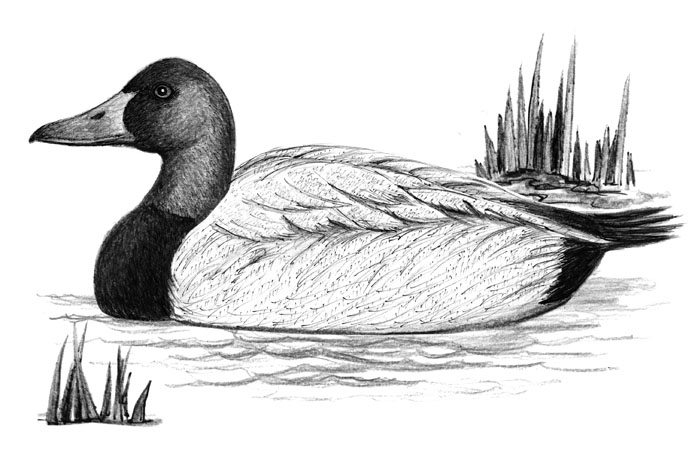
Dear Bird Folks,
Last week you wrote a column about the whistling-ducks down South and that got me thinking that I haven’t seen one of my favorite ducks the Canvasback, around here in years. Has something happened to them or am I just not looking in the right place?
– Charlotte, Harwich, MA
Me, too, Charlotte,
I too am a big fan of Canvasbacks. I like their coloring and their distinctive profile, which makes their heads look like doorstops. But what I really like is their name. It’s totally obscure and not very duck-like. Tell a group of non-birders that you just saw some Canvasbacks and they’ll think you are talking about a pair of slip-on shoes or some kind of camping equipment. Their odd name comes from the coloring of the male’s back, which is a mixture of light gray and white, making it look like a piece of canvas (or my hair for the past few years). Your note got me wondering if these ducks had really disappeared from the Cape, so I decided to see for myself. I know a spot that should be loaded with Canvasbacks. I’ll go there right now. Give me about an hour and I’ll have your answer.
Okay, I’m back and it doesn’t look good. For years one of the best places on Cape Cod to see Canvasbacks was Swan Pond in Dennis. The pond’s name would indicate that it’s a good place to see swans, and it is, but in the winter a whole assortment of ducks are usually found in this pond. In addition, there’s a good restaurant that overlooks the river that flows out of Swan Pond. It’s the perfect place to have lunch and watch the ducks swim past the window, so that’s where I headed. On today’s visit I saw buffleheads, Red-breasted Mergansers, and, of course Mute Swans, but not a single Canvasback. And to make things worse, I didn’t even have lunch in the restaurant, because they wanted $13.50 for a veggie burger. What? Are they kidding? Veggie burgers are made out of scraps! Even someone like me, who knows a lot about charging outrageous prices, had to pass on a $13.50 vegetable sandwich. Of course, if the sandwich was made of expensive birdseed, I’d understand the high cost, but I don’t think that was the case.
Nearly as big as a Common Eider, Canvasbacks are large diving ducks. But whereas eiders are worldly ducks, found from North America, to Europe to Siberia, Canvasbacks are homebodies. They never leave North America. (These birds know a good place when they see it.) Last week I mentioned that male and female whistling-ducks are basically identical to each other. This is not the case with Canvasbacks. The male doesn’t want to share his nest with any bird that looks like he does. He is a well-marked bird, with a chestnut-red head and neck, black chest, bright red eyes and a white body. The female, on the other hand can’t be bothered with all that flash. She’s mostly a plain gray-brown and likes it that way. It makes getting ready each morning ten times easier.
The majority of the world’s Canvasbacks breed in the prairie potholes that are found throughout the western grasslands. Prairie potholes are similar to Cape Cod’s kettle ponds, except that prairie potholes are found in the prairies and they aren’t filled with black labs swimming after tennis balls. Potholes were formed during the last ice age, back when wild glaciers roamed North America. The main water source for these potholes is mainly rain and melting snow, and this can be a problem. If there is a shortage of rain or a deficient amount of snowfall during a particular year, the potholes may run dry, and thus the ducks’ breeding success rates suffer. The lack of water isn’t the only problem these birds face each year. It seems a lot of people really like Canvasbacks, and I’m not talking about people like you and me. Hunters are fond of these ducks, too, and that’s never a good thing.
Canvasbacks have earned the regrettable title of “King of the Ducks,” because in addition to be being handsome birds, they are also delicious. During the dreaded market hunting days of the last century, a single Canvasback was worth four Mallards. Mallards were, of course, insulted by this lack of respect, but thought it wise not to complain. Over-hunting, combined with a host of other environmental issues, has contributed to a sharp decline in the Canvasbacks’ population. But it’s not all bad news for the King of the Ducks. Thanks to hunting restrictions and improvements made to the birds’ breeding and wintering grounds, we have seen a rebound in their population. 🙂
Unfortunately, Cape Cod has not been a benefactor of this rebound. There have been a few Canvasbacks seen around the Cape this winter, but not nearly as many as there once were. Why haven’t they come back? I don’t think anyone knows for sure, but I wouldn’t mind pointing a finger at the increase in the Mute Swan population. Loved by the public, but despised by environmentalists, the invasive swans might be sucking down all the aquatic plants that Canvasbacks depend upon. 🙁
It was sad to scan Swan Pond today, Charlotte, and not see a single Canvasback. I’m not sure if their local decline has anything to do with the increase in the number of Mute Swans. It’s just one of my theories. My other theory is that the ducks somehow got word that a neighborhood restaurant is charging $13.50 for a veggie burger and they decided to boycott the area in protest. Even ducks know a rip-off when they see it.